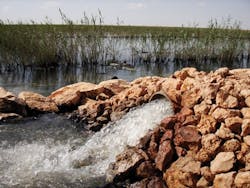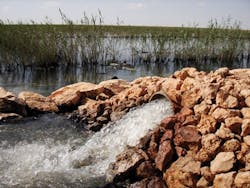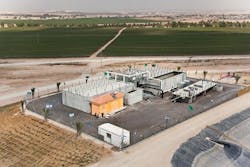Although Australia is one of the driest countries in the world, its groundwater has been "neglected, undervalued and poorly understood". A five year research programme, involving a centrifuge facility allowing researchers to effectively speed up time, aims to predict aquifer contaminant behaviour. The NCGRT provides an update on the project.
Beneath the red and black dirt that covers much of Australia - located in the second driest continent on the planet - lies vast reserves of underground water, the secrets of which researchers are hoping to unlock. Groundwater is a vital resource that comprises 30% of the country's total water consumption.
These underwater reservoirs are the largest source of fresh water in what is a hugely arid continent – they hold enough water to fill all of Australia's dams or the iconic Sydney Harbour many thousands of times.
They are regularly refreshed by floodwaters that seep into the earth and are stored and transmitted through a system of confined aquifers, permeable rock formations that lie deep underground, overlain by aquitards - relatively impermeable rock or clay that limits groundwater movement into, or out of, the aquifer. The Great Artesian and the Murray Darling Basins are crucial to ensure the future of Australia's population, but human activity such as coal seam mining and irrigation may impact on these water resources.
A five year project on aquitard research by Australia's National Centre for Groundwater Research & Training (NCGRT) is halfway through and aims to ensure the future of Australia's groundwater resources. Researchers at the University of NSW (UNSW) node of the NCGRT are hoping to better understand long-term effects of both natural events and human intervention on this vital resource, and are being helped by a state-of the art centrifuge permeametre facility, allowing them to "speed up time".
This facility will allow researchers to study the movement of water and contaminants through the aquitards. By subjecting samples of aquitards, as well as "cap rocks" which sit above some aquifers, researchers will be able to determine how much water or contaminant will move into or out of an aquifer once it is disturbed by drilling or pumping bores.
Professor Ian Acworth, who is joint leading the project, says: "It's basically like a time machine – you speed up gravity about 300 times beyond normal and that in turn speeds up the response of the aquifer to events such as water extraction and dewatering."
Professor Acworth says centrifuge testing could be included in environmental assessment processes for coal bed methane extraction and coal mining. This would give a clear indication of which aquifers are suitable for mining operations and which are vulnerable to compromise of water reserves. The research, centred around the Namoi catchment area of the Murray Darling Basin, which is around 400 kilometres north-west of Sydney, is part of the wider vision to improve Australia's understanding and management of critical groundwater resources.
Focused on relatively shallow aquifers to about 40 and 80 metre depths, the water contained within these gravel and sands are critical for irrigation and town water supplies.
Researchers have identified several key research focuses and consider this a high priority given that the lack of knowledge of the moisture content, storage, hydraulic conductivity and water quality of the many aquitards in Australia is a major threat to groundwater resource security. Over very long time scales, the diffusional losses evident in many aquitards mean that they also play a vital role in aquifer water quality.
Given how deep underground this complex system of aquifers and aquitards lies, and its vast geographical footprint, it has been difficult in the past to visualise exactly how it works, and what impact human intervention has had on the future of this vital groundwater reserve.
It is evident that should groundwater extraction exceed recharge, aquifers will be depleted. This, in turn, will threaten Australia's efforts to manage stressed surface water resources, with adverse consequences for communities, agriculture and industry. It will also reduce the river flows needed to sustain groundwater-dependent ecosystems such as wetlands and some riparian forests.
Led also by Dr Wendy Timms, an integral component of the UNSW aquitards project is to better understand what effect activities such as irrigation and coal seam mining will have on the future of the basin. As more water is taken out of aquifers for these purposes, the aquifers can depressurise. This means they may compress and compact and the aquitards above them may subside.
Dr Timms says coal bed methane built up underground where "disconnections" – barriers such as clay or rock that obstruct the natural flow of water or gas – occurred.
"The key question is how the degree of connection might change when groundwater pressures change as a result of drilling and the centrifuge will help us understand that," she says.
Centrifugation could study geological media in saturated, unsaturated and variable saturation state and help bridge these gaps. It is expected that centrifugation can also directly address questions of sub-surface flow at scales that are not otherwise possible. For example:
- Time scales – By quantifying flow processes that occur over decades and centuries in the environment, centrifuge models can simulate flow over thousands of years within a reasonable experimental time frame of weeks or months. It can also provide realistic measurements and observations to support numerical modelling of very long term processes that occur in the sub-surface (for example, hydraulic responses in sedimentary basins over millennia)
- Spatial scales and heterogeneity - Small centrifuge models can simulate thick geological media or replicate numerous permeability type tests to assess spatial heterogeneity. Studies of leakage through aquitard windows has for example identified pathways on a scale of metres and tens of metres as being critical, yet unquantified in groundwater systems. Scale modelling of complex groundwater systems in a centrifuge tank provides this capability
- In-situ stresses - Centrifugation enables testing of geological media at in-situ stresses that occur at depth of burial. This capability is particularly important for compressible media such as clay aquitards
- Direct observation of physical processes - Centrifugation can obtain realistic input data for numerical modelling by direct observation and measurement performed in flight. Development of techniques such as centrifugation has lagged considerably behind complex numerical modelling and computing power.
The centrifuge facility, and the research undertaken there, forms the basis of a sub-program within one of the NCGRT's five core programs. This includes the first program, entitles "Innovative characterisation of aquifers and aquitards", directed at overcoming major inadequacies in available hydrogeologic conceptualization and field measurement methodologies.
While centrifugation is an accepted technique in geotechnical engineering, it remains largely unexplored in hydrogeology. This facility recognises and appreciates the power and utility of centrifugation within the water resources and hydrogeological profession. Researchers hope the facility will address a critical gap in knowledge between soil science and hydrogeology. WWi
Author's note: For more information on the NCGRT and centrifuge research project, email Laki Kondylas: [email protected]
Technical Details: Centrifuge
The centrifuge is only one of two of its kind in the world and is unique for the following reasons:
- It is the first core permeameter centrifuge in the world capable of direct testing of minimally disturbed drill core of 65-100 millimetre diameter, which can be retrieved without rotation, distortion, or compression of geological material using standard coring equipment. The core is considered to be the optimum diameter to achieve representative flow for this type of testing. Another key benefit is that it will be possible to sample from the core while the centrifuge is in operation.
- It is capable of higher g-levels than typical geotechnical centrifuges (i.e., 300 gmax at 0.7 metre radius as compared with 80 gmax typical), which is essential to drive fluid through low-permeability aquitard material. Calculations indicate that material with a hydraulic conductivity of 10-12 metres per second can be tested with this equipment.
- The modular centrifuge base is the one of only two in the world operating with both core permeameter and tank testing systems (the other is at the University of Texas in the USA). The swing-tank rotating on a small beam enables the tank to be set up to study layered groundwater systems, heterogeneous sediments, discontinuous aquitards and the potential impact of fault lines and leaky bores at a suitable physical scale. A 0.3 metre thick groundwater model at a scale of 300 grams would represent a 90 metre thick groundwater system in the field. The ability to speed up time using this method, when combined with field and bore tests and used to improve computer models, will significantly enhance long term predictions of understanding of subsurface flow and transport.
Australia's National Centre for Groundwater Research
Headquartered at Flinders University in South Australia, the centre represents a nationwide alliance of 21 universities, as well as government and industry partners. It promotes global collaboration with nearly 200 Australian and international researchers all focussed on understanding Australia's aquifer systems, as well as training the next generation of groundwater experts Established in 2009, the Centre is funded through $30 million from the Australian Federal Government (through the National Water Commission and the Australian Research Council), with partner organisations contributing a further $30 million. These partners are made up of a consortium of leading universities, public research bodies, state government agencies and private industry. As well as combining the knowledge of international and nationally regarded researchers in the field, the NCGRT also has 97 honours, postgraduate and postdoctoral students at research locations across Australia. These students are all undertaking high level studies in hydrogeological and related technologies, helping fill Australia and the world's knowledge and skills gap in this vital discipline.
More Water & WasteWater International Archives Issue Articles






